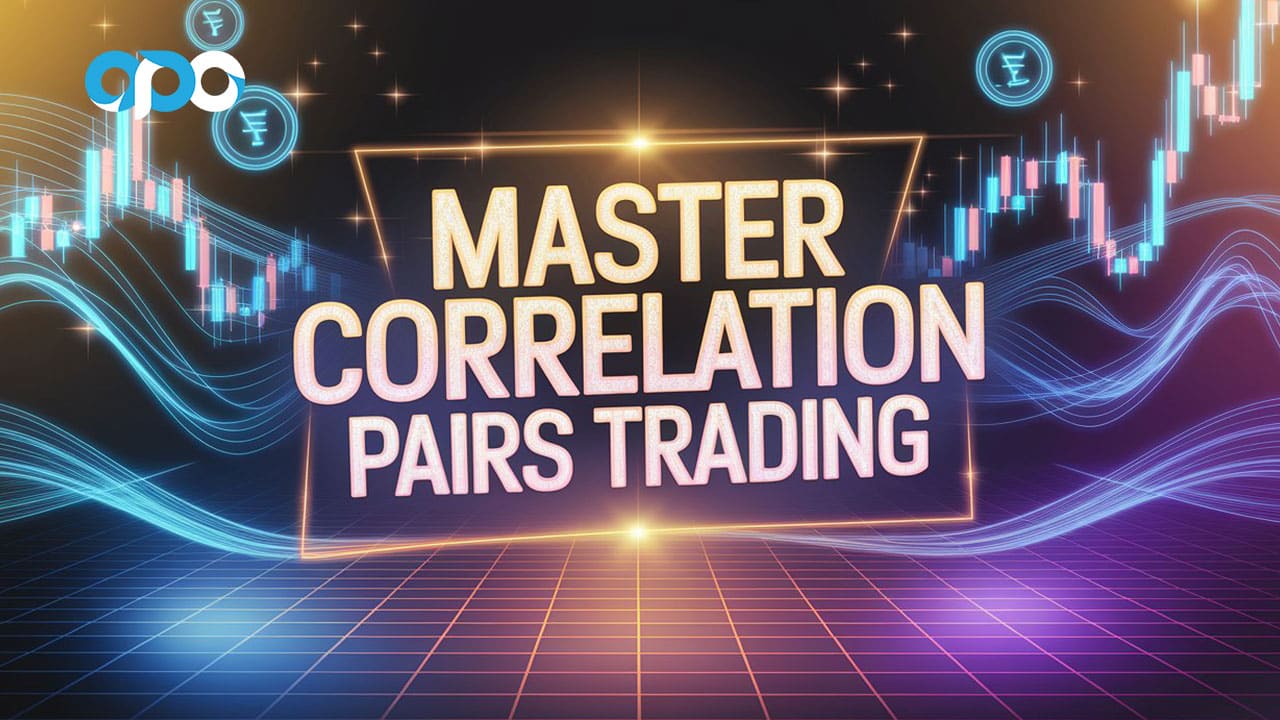Feeling tossed around by the unpredictable waves of the forex market? It’s tough trying to guess where currencies are heading next, and the constant uncertainty can be stressful, potentially leading to losses. Many traders get caught out by sudden market shifts. But what if there was a way to trade that didn’t rely so heavily on predicting direction? The correlation pairs trading strategy in forex offers just that. It’s a smart approach, available through many forex trading brokers, that focuses on the relationship between two currency pairs, aiming to profit from temporary imbalances. This article will guide you through understanding and applying this fascinating market-neutral strategy.

What is Pairs Trading?
At its heart, pairs trading is about playing the difference, not picking winners. It’s a strategy designed to work whether the market’s soaring, sinking, or just drifting along – what we call ‘market-neutral’. Instead of betting on one currency pair going up or down, you take two positions at the same time: you buy one asset and sell another that’s closely related (correlated). The whole idea is to cash in when the usual price relationship between these two assets temporarily goes out of whack, expecting things to return to normal eventually. It’s about relative value, not absolute direction.

Understanding Forex Currency Correlation
Think of the forex market like a complex dance floor. Currencies rarely move alone; they react to economic news, political shifts, and general market vibes, often causing them to step in sync or in opposition to each other. This relationship is called correlation. Getting a handle on forex currency correlation is key because it tells you how one pair’s moves might hint at another’s. It’s like knowing which dance partners tend to stick together. This understanding is the foundation for strategies like the correlation pairs trading strategy.
Defining the Correlation pairs trading strategy
So, what exactly is the correlation pairs trading strategy? It’s taking the general idea of pairs trading and applying it specifically to forex. You find two currency pairs that historically have a strong connection – they either tend to move in the same direction or in opposite directions. Then, you watch the ‘spread’, which is the difference in their prices. If this spread widens or narrows much more than usual, breaking away from its historical pattern, the strategy kicks in. You’d buy the pair that’s lagging (the underperformer) and sell the pair that’s racing ahead (the outperformer), betting that they’ll eventually fall back into their typical relationship.
How Does Pairs Trading Work? (Market-Neutral Approach)
Pairs trading lets you sidestep the often-frustrating game of predicting the market’s overall mood. By buying one correlated asset and selling the other simultaneously, you create a position that’s less sensitive to broad market swings. Imagine trading EUR/USD and GBP/USD, which often move together. If you’re long EUR/USD and short GBP/USD, and suddenly negative news hits both Europe and the UK, the loss on your long position could be cushioned by the gain on your short position. Your profit potential comes from the difference (the spread) between the two pairs getting back to its normal level after a temporary blip. This focus on the spread makes it a classic example of a market-neutral strategy.
Core Concepts of Forex Correlation
Forex correlation is simply a way to measure how much two currency pairs move together over time. It’s a number that helps us see the hidden connections in the global currency market. These connections happen for various reasons: maybe two countries trade a lot with each other, maybe both currencies are heavily influenced by oil prices, or perhaps they both react similarly to global investor confidence (risk-on/risk-off moods). Understanding these links is super important for managing risk and spotting opportunities for a correlated pairs forex strategy.

Positive vs. Negative Correlation Explained
Correlation comes in two main flavors:
- Positive Correlation: This is when two currency pairs generally move in the same direction. If EUR/USD goes up, a positively correlated pair like GBP/USD is likely to go up too (and vice versa). A perfect score here is +1.
- Negative Correlation: This is when two pairs tend to move in opposite directions. If EUR/USD climbs, a negatively correlated pair like USD/CHF is likely to fall (and vice versa). The perfect score for this is -1.
- Zero Correlation: If two pairs move totally independently, their correlation is close to 0.
Knowing if pairs move together or opposite ways is step one for building a pairs trade or a hedge.
Measuring Correlation: The Correlation Coefficient
We use the correlation coefficient to put a number on this relationship. It ranges from -1 to +1:
- +1: Perfect positive sync. They move together, always in the same direction.
- -1: Perfect negative sync. They move perfectly opposite each other.
- 0: No connection at all. Their moves are random relative to each other.
In the real world, +1 or -1 rarely happens. Traders usually look for strong correlations – generally above +0.7 or below -0.7 – when planning a correlation pairs trading strategy in forex. Anything between +/- 0.4 and +/- 0.7 is moderate, and closer to zero is weak. Stability over time is just as important as the strength.
Why Correlation Matters in Forex Trading
Why bother with correlation? First, it’s huge for risk management. If you don’t realize you’re holding several positions in pairs that all move together, you might be taking on way more risk than you think, all tied to the same underlying factor. Second, it helps you diversify. Choosing pairs with low or negative correlation can spread your risk around. Third, and most relevant here, it’s the engine behind the correlation pairs trading strategy and the forex correlation hedging strategy. It lets you trade relative value or protect existing positions.
Identifying and Selecting Forex Pairs
Choosing the right dance partners is crucial for this strategy. It’s not enough to find pairs that moved together in the past; you need pairs where the correlation is strong, reasonably stable, and makes sense based on economic links. This takes some homework and continuous checking, as these relationships aren’t set in stone.
Read More: Types of Currency Pairs in Forex

Finding Highly Correlated Currency Pairs
Your main tools here are correlation calculators or matrices, often found on trading platforms or financial websites. You’ll want to look at correlations over different timeframes (like the last 3 months, 6 months, or year). Aim for pairs showing consistent readings above +0.7 or below -0.7. It’s also smart to ask why they are correlated. Is it shared trade links, reliance on the same commodity, or similar risk profiles? Understanding the ‘why’ gives you more confidence that the correlation might stick around.
Examples of Strong Positively Correlated Pairs
Some pairs just naturally tend to move together due to their economies or location:
- EUR/USD & GBP/USD: These majors often trend together against the US dollar due to the close economic ties between the Eurozone and the UK.
- AUD/USD & NZD/USD: The “Aussie” and “Kiwi” dollars often move in tandem. Both are considered commodity currencies, their economies are closely linked, and they are sensitive to similar factors like Asian economic health and commodity prices.
Read More: Most Correlated Forex Pairs
Examples of Strong Negatively Correlated Pairs
Negative correlation often pops up when the USD is on opposite sides of the pairs, or they represent opposing economic safe-havens vs. risk assets:
- EUR/USD & USD/CHF: These often move in opposite directions. When investors feel confident and buy Euros (pushing EUR/USD up), they might sell the safe-haven Swiss Franc (pushing USD/CHF down), and vice-versa during times of uncertainty.
Commodity Currency Correlations
Some currencies have a strong link to commodity prices because their countries export a lot of that resource:
- AUD/USD & Gold (XAU/USD): Australia digs up a lot of gold, so the AUD often strengthens against the USD when gold prices rise (positive correlation).
- USD/CAD & Oil (WTI/Brent): Canada exports a lot of oil. Typically, when oil prices go up, the Canadian dollar strengthens, causing the USD/CAD pair to go down (negative correlation).
Keeping these commodity links in mind adds another dimension when searching for pairs for your correlated pairs forex strategy.
Developing a Correlation pairs trading strategy
Okay, you’ve found a promising pair. Now what? The next stage is building your actual trading plan. This means setting clear rules for spotting when the pairs’ relationship deviates, when to jump in, and when to get out, all based on the idea that things will eventually get back to normal (mean reversion).

The Principle of Mean Reversion in Pairs Trading
Mean reversion sounds fancy, but it’s a simple idea: things tend to return to their average over time. Think about your commute – some days it’s faster, some days it’s slower, but it tends to average out. In pairs trading, we assume the ‘spread’ (the price difference or ratio) between two correlated pairs will do the same. When it temporarily stretches too far from its average due to market noise, we bet on it snapping back. That snap-back is where the potential profit lies.
Identifying Divergence (Spread Deviation) Between Pairs
Divergence is just the moment when our correlated pairs stop dancing in sync. Their prices move in a way that stretches their normal relationship, causing the spread between them to move significantly away from its average. You can track this spread by charting the difference (Pair A Price – Pair B Price) or the ratio (Pair A Price / Pair B Price). Often, traders use statistical tools like standard deviation bands around the spread’s average. When the spread moves, say, 2 standard deviations away from its average, it signals a potential divergence – one pair might be temporarily overpriced relative to the other.
Strategy Execution: Long the Underperformer, Short the Outperformer
When you spot a significant divergence, the classic move in the correlation pairs trading strategy is:
- Figure out who’s lagging and who’s leading: Which pair has become relatively ‘cheap’ (underperformer) and which has become relatively ‘expensive’ (outperformer) compared to their usual connection?
- Place the trade:
- Buy (go long) the underperforming pair.
- Sell (go short) the outperforming pair.
You’d ideally do this simultaneously, using position sizes that keep your overall market exposure roughly neutral. The aim is to profit when the spread between them shrinks back to its normal range.
Step-by-Step Implementation Guide
Putting a correlation pairs trading strategy in forex into action needs structure. Here’s a practical sequence to follow:

Step 1: Select Historically Correlated Pairs
Start by hunting for pairs with a solid track record of correlation. Use tools like correlation matrices to find pairs consistently showing strong positive (e.g., > +0.7) or negative (e.g., < -0.7) correlation over a decent period (like the last 6-12 months). Bonus points if you understand the economic reasons why they’re linked.
Step 2: Analyze Correlation Strength and Stability
Don’t just glance at today’s number. Check if the correlation has been steady over time. A relationship that jumps all over the place isn’t very reliable. Look at rolling correlation charts if possible – these show how the correlation has changed over time. Stability is key.
Step 3: Monitor Pairs for Divergence from Norm
Calculate and chart the spread between your chosen pairs (either Price A – Price B or Price A / Price B). Add a moving average to see the spread’s typical level. Use tools like standard deviation bands (like Bollinger Bands applied to the spread) to define ‘normal’ and ‘extreme’ zones. Watch for when the spread moves significantly away from its average (e.g., hits the 2-standard-deviation band).
Step 4: Determine Entry Points Using Technical Indicators
The main trigger is the spread deviation, but you can refine your entry. Some traders look for confirmation using indicators like RSI or Stochastics applied to the spread chart itself, or they check basic support/resistance on the individual pair charts to avoid jumping in right before the divergence gets even wider.
Step 5: Execute the Paired Trade (Long/Short)
Once your entry signal fires (significant spread deviation plus any confirmation), place your trades: buy the underperformer, sell the outperformer at the same time. Getting the position sizes right is important for staying market-neutral. Often traders size based on volatility (like using the Average True Range or ATR) or ensure equal notional value.
Step 6: Monitor and Close the Trade When Spread Converges
Now, watch that spread! Your main exit signal is when it returns towards its average (your profit target). Maybe that’s the moving average, or maybe it’s back to zero deviation. Equally important: know where you’ll cut your losses if you’re wrong. Set a stop-loss based on the spread widening further (e.g., reaching 3 standard deviations) or exit if it hasn’t converged after a set amount of time. Close both positions together.
Tools and Indicators for Pairs Trading
Certain tools really shine when you’re working with a correlated pairs forex strategy, helping you analyze relationships and spot chances.

Using the Correlation Coefficient
This is your starting point. Regularly checking correlation matrices helps you find potential pairs and ensure existing relationships are still valid. Many trading platforms have built-in correlation tools.
Analyzing the Spread and Moving Averages
Charting the spread (the price difference or ratio) is non-negotiable. Adding a simple moving average (SMA) to this spread chart quickly shows you its historical average. Watching the spread cross this average, or move far away from it, highlights potential opportunities.
Applying Bollinger Bands to Identify Deviations
Bollinger Bands are fantastic when applied directly to the spread chart. They plot standard deviations (usually 2) above and below the spread’s moving average. If the spread hits the upper band, it’s statistically stretched (potential signal to short the spread: short the outperformer, long the underperformer). If it hits the lower band, it’s statistically compressed (potential signal to long the spread, though this is less common for mean reversion). The bands adjust automatically to how volatile the spread is.
Utilizing Correlation Strategies in Forex
Understanding correlation isn’t just for the mean-reversion pairs trade. It unlocks other useful tactics like hedging risk, diversifying intelligently, confirming signals, and even spotting rare arbitrage-like situations.
Hedging Risk with Negatively Correlated Pairs
This is the core idea behind a forex correlation hedging strategy. Let’s say you’re holding a long EUR/USD position but worry about a potential drop. Instead of closing it, you could take a long position in a strongly negatively correlated pair like USD/CHF. If a wave of USD strength hits the market, causing EUR/USD to fall, USD/CHF would likely rise, helping to offset your loss on the EUR/USD position. It’s not always a perfect counterbalance, but it can definitely smooth out the ride.
Diversifying Exposure Across Different Pairs
Correlation smarts help you build a less risky portfolio. If you’re already heavily invested in, say, AUD/USD, adding another position in the highly correlated NZD/USD might just double your exposure to the same underlying risks. Instead, look for trades in pairs with low or negative correlation to your existing positions. This spreads your bets across different economic drivers.
Read More: Forex Pairs with Least Correlation
Confirming Trading Signals with Positively Correlated Pairs
Got a buy signal on EUR/USD from your favorite indicator? Check what its correlated buddy, GBP/USD, is doing. If GBP/USD is also looking bullish or breaking resistance, it adds a layer of confirmation to your EUR/USD idea. But if GBP/USD looks weak or bearish, it might be a sign to be cautious or reconsider the EUR/USD trade.
Identifying Potential Arbitrage Opportunities
True, risk-free arbitrage is like a unicorn in liquid forex markets – rare and hard to catch. However, sometimes significant, temporary glitches occur in the pricing of highly correlated assets (like two related currency pairs or a pair and its related CFD). These can create statistical arbitrage opportunities, where you exploit tiny, short-lived deviations. It’s complex and usually the domain of high-speed algorithmic traders, but the principle stems from correlation breakdowns.
Benefits of the Correlation Pairs Strategy
Why consider the correlation pairs trading strategy in forex? It has some attractive perks, especially if you’re tired of just betting on direction.
Profit Potential Regardless of Market Direction
Since you’re betting on the relationship between two pairs returning to normal, you can potentially make money whether the overall market is bullish, bearish, or flat. It’s the spread convergence that matters, not which way the wind is blowing overall.
Built-in Hedging Mechanism
Holding a long and a short position in related pairs automatically provides some hedging. If a market event hurts your long position, it might simultaneously benefit your short position (or vice-versa), cushioning the blow.
Reduced Directional Market Risk
This follows directly from the market-neutral approach. You’re less exposed if you guess the market’s overall direction wrong, which is often the hardest part of trading.
Potential for Smaller Drawdowns Compared to Directional Trades
Because the hedge effect often dampens volatility, the ups and downs of the combined pairs trade (the spread) can be smoother than trading just one pair. This might lead to a less bumpy ride for your account balance, provided the correlation holds up.
Risks and Considerations
It’s not all smooth sailing, though. The correlation pairs trading strategy comes with its own set of risks you absolutely need to be aware of.
The Risk of Correlation Breakdown
This is the big one. Just because two pairs moved together for years doesn’t mean they’ll do so tomorrow. Economic policies change, trade relationships shift, unexpected events happen. If the correlation falls apart after you’ve put on your trade, the spread might never revert, and you could lose money on both the long and the short positions.
Challenges in Finding Consistently High Correlations
Finding pairs with super strong, rock-solid correlations that last is harder than it sounds. Correlations ebb and flow. Relying on a relationship that’s weakening or volatile is risky business.
Historical Data Doesn’t Guarantee Future Correlation
We have to say it again: past performance doesn’t predict the future. Simply picking pairs based on historical numbers without understanding why they were correlated, or without watching for changes, is asking for trouble.
Potential for Amplified Losses if Both Pairs Move Adversely
If the correlation breaks down in the worst possible way – your long position tanks and your short position skyrockets – your losses can add up very quickly, potentially even faster than a simple directional trade gone bad.
Need for Continuous Monitoring and Analysis
This isn’t a strategy you can set up and walk away from. You need to constantly watch the spread, keep checking if the correlation is still strong, and stay alert to news that could shake up the relationship between your chosen pairs.
Best Practices for Trading Correlated Pairs
To navigate the risks and boost your chances when using a correlated pairs forex strategy, stick to these good habits:
Perform Regular Correlation Analysis
Don’t set it and forget it. Keep checking those correlation numbers regularly (daily, weekly) across different timeframes. Make sure the relationship you’re trading still makes sense.
Combine Correlation with Other Analysis
Correlation alone isn’t enough. Layer in some basic technical analysis (like support and resistance) on the individual pairs and the spread chart. Stay aware of major economic news releases that could impact either currency.
Be Aware of Market Conditions Affecting Correlations
Correlations aren’t static; they can change depending on the overall market mood. During major risk-off events, for example, correlations you normally rely on might strengthen, weaken, or break entirely. Factor this into your thinking.
Implement Proper Risk Management and Position Sizing
Non-negotiable. Always use a stop-loss for your pairs trade, typically based on the spread widening beyond a certain threshold. Size your positions carefully (often aiming for dollar neutrality) to balance the two legs and control your overall risk.
Backtest Strategies Before Live Trading
Before you risk real money, test your specific pairs trading rules (entry triggers, exit rules, pairs selection) on historical data. See how it would have performed, what the potential drawdowns look like, and if it’s realistically profitable.
Consider Starting with a Demo Account
Juggling two positions, calculating spreads, monitoring correlations – it takes practice. Get comfortable with the whole process on a demo account first. Work out the kinks before going live.
Opofinance Services: Enhance Your Forex Trading
Thinking about trying out strategies like correlation pairs trading? Opofinance, regulated by ASIC, offers a great environment and tools to support your trading:
- Advanced Trading Platforms: Take your pick from the popular MT4 and MT5, the feature-rich cTrader, or Opofinance’s own user-friendly OpoTrade platform.
- Innovative AI Tools: Leverage the power of AI! Use the AI Market Analyzer for deep insights, get personalized tips from the AI Coach, and access quick help via AI Support.
- Social & Prop Trading: Learn from others with social trading features or explore opportunities to trade firm capital through prop trading programs.
- Secure & Flexible Transactions: Manage your funds easily and securely. Opofinance offers convenient deposit and withdrawal options, including crypto, with zero fees charged by them.
Partner with a broker focused on technology and helping traders grow.

Conclusion
The correlation pairs trading strategy in forex offers a refreshing, market-neutral way to approach currency trading. By focusing on the relationship between two linked pairs and trading the expectation that their price spread will revert to its average, traders can find opportunities independent of the market’s overall direction. It brings built-in hedging benefits and can potentially smooth out equity curves. However, it demands discipline: careful selection of pairs, constant monitoring of the correlation’s health, and strict risk management are essential to handle the very real risk of correlations breaking down. Used wisely, it’s a powerful technique for the strategic forex trader.
Key Takeaways
- Pairs trading aims for profit from relative price changes between two correlated assets, making it market-neutral.
- Forex correlation (+1 to -1) measures how pairs move relative to each other.
- The correlation pairs trading strategy in forex involves buying the underperformer and selling the outperformer when their spread deviates, expecting mean reversion.
- Focus on strong (> |0.7|), stable correlations with understandable economic links.
- Essential tools: Correlation data, spread charts (with MAs, Bollinger Bands).
- Benefits: Market-neutral profit potential, built-in hedging, reduced directional risk.
- Key Risk: Correlation breakdown leading to potential losses on both trade legs.
- Must-Dos: Regular analysis, risk management (stops, sizing), backtesting, demo practice.
How do interest rate changes affect forex correlations?
Interest rate changes (or even just expectations) from central banks are huge drivers for currencies and can definitely shake up correlations. If one country’s central bank starts hiking rates while its correlated partner’s bank stays put, money might flow to the higher-yielding currency, weakening the historical correlation between their pairs. Keeping an eye on central bank news is vital for pairs traders.
Can pairs trading be fully automated?
Absolutely. Pairs trading follows clear rules, making it a good candidate for automation with trading bots (like Expert Advisors in MT4/MT5). An algorithm can track correlations, calculate spreads, spot deviations, execute the buy/sell orders, and manage exits 24/7. However, developing, testing, and maintaining a reliable automated system takes serious coding and analytical skills.
What are common mistakes traders make with correlation pairs trading?
Some frequent slip-ups include: relying on old or shaky correlation data, not understanding why pairs are correlated, forgetting to set stop-losses specifically for the spread widening, messing up position sizes (losing neutrality), jumping into trades too early when divergence might increase, ignoring news that could break the correlation, and skipping crucial backtesting or demo trading phases.







